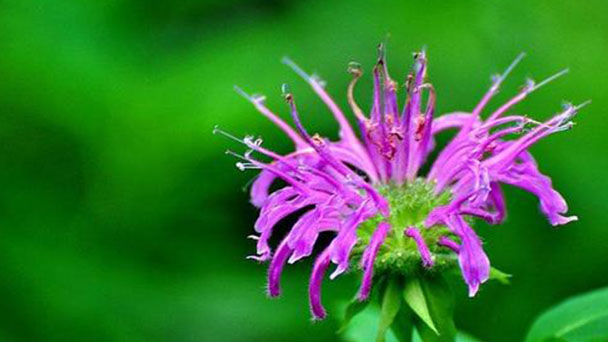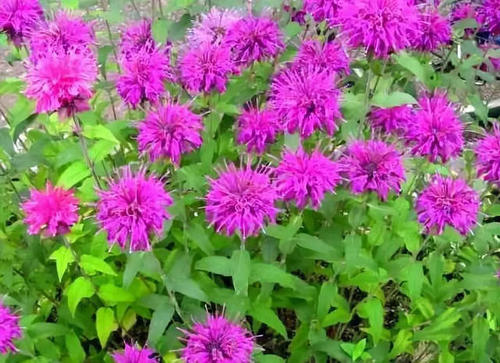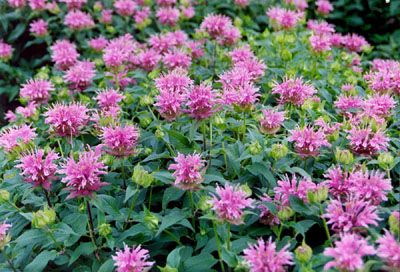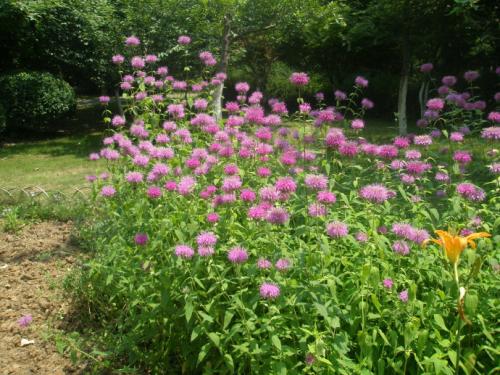Monarda didyma (Scarlet beebalm) profile
Written by Maggie
Mar 09 2021

Monarda Didyma, also called the crimson beebalm, scarlet beebalm, scarlet monarda, Oswego tea, or bergamot, is a perennial herb, plant height 100-120 cm, erect, four-pronged, leaves thin, opposite, ovate or ovate-lanceolate, pubescent back, serrated margin. Monarda Didyma flowers are close to the apex of the stem, calyx slender, corolla 5 cm long, clustered at the apex of the stem, corolla tubular, lavender red, leaves fragrant. Cymbrella is densely flowered, tube distally slightly enlarged, lobes slightly diciliate.
Monarda Didyma is native to America and is grown in gardens all over China. Monarda Didyma can be used for tea, decocting, barbecue, raw food, pickling, sauce. Monarda Didyma can also be used for sterilization, bathing, incense. Ointments are made to treat skin rashes. Inhaling steam can relieve cold symptoms. It is often added to hair care products.
Monarda Didyma picture

Monarda Didyma info
| Botanical Name | Monarda didyma |
| Common Names | the crimson beebalm, scarlet beebalm, scarlet monarda, Oswego tea, or bergamot |
| Plant Type | Herbaceous perennial |
| Light | Full sun to part shade |
| Native Areas | Canada, United States |
| USDA hardiness | 4 to 9 |
| Flower | Showy, Good Cut |
| Mature size | 2.00 to 4.00 feet high, 2.00 to 3.00 feet wide |
Morphological characteristics of Monarda Didyma
Stems
Monarda Didyma is an erect annual herb. Stems sharp are tetragonal, striate, subglabrous, pubescent only on nodes or distally along edges, hairs readily glabrescent.
Leaf
Monarda didyma leaves lanceolate oval, up to 10 cm long, 4.5 cm wide, apex acuminate or long acuminate, base rounded, the margin of sawtooth, paper, green above, below is pale, the hydrophobic pilose, hairs gradually fall off, the only along veins, pilose, glandular dots more than spreading sag, lateral veins 9-10, in the flat below the bump, rib on the obvious sag, the uplift, net veins only visible below; Stem middle petiole as long as 2.5 cm, short upward, near sessile at the top, concave back convex, slightly wide base, when young dense by a long pubescent, old-time bald net.
Flowers
Inflorescences of Monarda didyma are many-flowered, forming a dense head up to 6 cm in diameter at stem apex; Bracts are leaflike, reddish, shorter than inflorescence, shortly stipitate, entire, sparsely pubescent, lower mask recumbent glandular, bracteoles linear-subulate, ca. 1 cm long, base 1.5 mm wide, apex long caudate, ribbed, puberulent, red; Pedicels of Monarda Didyma are short, ca. 1 mm long, puberulent. The calyx is tubular, slightly curved, ca. 1 cm long and 2.5 mm wide, purplish-red when dry, 15-veined, outside pubescent along ribs, inside sparsely bristling at the throat, calyx teeth 5, subulate triangular, ca. 1 mm long, apex sharply spiked, equal in size. Corolla is purplish red, ca. 2.5 times as long as calyx, puberulent outside, puberulent inside in tube, corolla 2-lipped, upper lip erect, apex slightly curved, entire, lower lip 3-lobed, spreading, middle lobes longer, apex emarginate. Monarda Didyma can produce stamens 2, recumbent upper lip slightly extruding, filaments glabrous, anthers linear, the middle is born. Style is beyond stamens, glabrous, apex unequally 2-lobed.
Ecological habits of Monarda Didyma
Monarda Didyma likes a cool, wet, sunny environment, also tolerant of half shade. Monarda Didyma has strong adaptability, do not choose the soil. Monarda Didyma has cold resistance, avoid too dry. The growth is most vigorous in moist, semi-shady thickets and woodlands.
How to grow and care for Monarda Didyma
Monarda Didyma has introduced to Europe about 300 years ago and has been cultivated for more than 200 years. It has been cultivated as a spice for a long time.
Soil
Monarda Didyma's requirements for soil are not strict and can withstand barren conditions. Monarda Didyma can grow in normal soil, but it is better to grow in fertile, loose, moist and well-drained soil. Growth is best in the thick, moist, organic matter - rich understory sandy loam. In North China can be overwintered in the open, in the Nanjing area in winter evergreen. The potted substrate can be used leaf rot soil, garden soil, coarse sand and other materials prepared. Because of the fast growth rate, it is advisable to turn the basin once a year, usually in spring and autumn.
Planting distance
Monarda Didyma is usually transplanted in the spring in combination with adjustment. Plant row spacing should be 30 cm ×40 cm, and each pot should be 3-5 plants. Divide plants once every 2-3 years to prevent over-dense plant clusters, affecting plant growth, flowering and fruiting, and reducing the ornamental effect.
The temperature
Monarda Didyma loves warmth. Monarda Didyma has strong cold resistance, North China can overwintering on the ground. Monarda Didyma likes full sun, slightly shade tolerance should be planted or placed in full sun. In the absence of light, the plants grow barren and the branches become thin. You need adequate shade in high summer.
Watering
Monarda Didyma likes a humid soil environment and has poor drought resistance. During the growth, the period should be fully supplied with water, keep the basin soil moist. Small seedling growth requires more water. But avoid too wet and water. The growing season should be watered thoroughly.
Fertilization
Monarda Didyma is fertilized every two months during the growing season. Fertilization after spring should be based on nitrogen to promote stem and leaf growth. In mid to late May, potassium fertilizer should be added before flowering to promote good flowering. Fertilizer, pay attention to more phosphorus, potash fertilizer, help to bloom, reduce the occurrence of diseases and insect pests.
Trim
Breeding seedlings of Monarda Didyma should be cut to control height and branching and pruned once in May-June to adjust plant height and flowering time. After flowering, the residual flower can stay in-branch apical, should cut a branch from the ground 5 cm or so place above part, be helpful for later flowering flourishing. Generally, appropriate pruning in spring, in May to June for a core, adjust the height of the plant, is conducive to the formation of plump plant shape and flowers flourishing. Pay attention to maintain good ventilation, timely removal of diseased branches and leaves.
How Monarda Didyma propagates
Monarda Didyma is often propagated by division, but can also be propagated by sowing and cutting.
Division propagation
Spring and autumn (dormant period). The plant has a strong tillering ability and can sprout many new buds around the old plant. As long as the new buds are dug out and planted separately, or the roots are cut and planted, 2-3 branches are cut and planted as a small cluster. The survival rate is high. Due to the strong expansibility of the plant, it should be planted in the ground at least once every 2-3 years, and the planting can be carried out in combination with turning over the pot.
Cutting propagation
Monarda Didyma cuttings can be used for mass production. April-5 months, cut the sturdy and substantial, long 5~8 cm of a year or two full branches as cuttings, inserted with peat, sand, bran ash and another mixed cutting matrix, keep half shade, moist, about 30 days can take root. Very high survival rate.
Seed propagation
Monarda Didyma sowing is mostly done in spring and autumn. The suitable temperature for germination was 21-24℃, and the germination rate was up to 90% after 10-21 days. Flowering 4 months after sowing. This method is only used inbreeding. Seedling should pay attention to ventilation, timely thinning and transplanting.

Disease control of Monarda Didyma
Monarda Didyma has fewer pests and diseases.
The plants of Monarda Didyma are prone to powdery mildew when they are too dense or the soil is wet. When it is serious, the aboveground part of the Monarda Didyma should be cut off completely and the plant should sprout and grow again. Others are leaf spot, rust and night moth, aphids and other pests. Occurs in the summer of dry heat more, a few kinds of mold can cause its seedling to suffer, should remove the branches and leaves of infection in time, spray in time fungicide prevention and control. In addition, the plant in too dense or wet soil prone to powdery mildew, after the occurrence of timely spraying control, serious, to the plant of all parts of the ground cut off, let the plant re-germination growth. Others are leaf spot, rust and night moth, aphids and other pests.
Variety classification of Monarda Didyma
"Garden Red" Monarda Didyma
'Garden Red' Monarda Didyma (Scarlet Gardenview) :
Plant height about 70 cm. Veins are usually purplish red. Flowers from mid-June to September, 100-180 small inflorescences 6 -- 11 cm in diameter, bracts and corolla bright red;
"Coro Red" Monarda Didyma
"Coro Red" Monarda Didyma (Monarda'Croftway Pink ') :
New leaves purple, turning purplish-red by mid-October. Scape 40-50 cm tall, inflorescence 180 -- 280 small flowers, about 6 cm in diameter, corolla labiate dehiscence large, lower lip margin undulate, soft pink, with a narrow white edge, full hemisphere throughout;
"Grassland" Monarda Didyma
"Grassland" Monarda Didyma (Monarda 'Prarienacht') :
Leaves ovoid, veins concave, leaf margin and back purplish red, in mid-October leaves purplish red. Mid-June to the end of August flowering, scapes 40 to 50 cm high, florets 160-320, arranged neatly, inflorescences about 6 cm in diameter, violet, labellum margin white;
"Fireball" Monarda Didyma
"Fireball" Monarda Didyma (Monarda×Firebair) :
Plant height 40-50 cm. Flowers from early July to late August, purplish red, inflorescences about 7 cm in diameter.
"Pink Pole" Monarda Didyma
Monarda Didyma (Monarda 'Pink Supreme') :
Plant height 40-50 cm.Flowers from early July to late August, deep pink
The distribution region of Monarda Didyma
Monarda Didyma is originally from the Americas, in Quebec, Canada, Georgia, Maine, North Carolina and other places in the United States.
Monarda Didyma is grown in gardens all over China.
Monarda Didyma uses
Edible value
Monarda Didyma can be used as a sauce, vinegar, vegetable, dessert or as candy. Peppermint oil has a cooling and refreshing effect. Monarda Didyma can also be used for flavoring drinks, toothpaste and medicines. Its essential oil can treat vomiting, peppermint itself has irritation, can help digestion, reduce gastrointestinal gas. The dried leaves of Monarda Didyma can be used in tea and as an aromatherapy herb. The aroma is similar to that of bergamot, with only slight differences.
The leaves of Monarda Didyma can be used as medicine. Crumped up and soaked in hot water as a tea, the leaves can cure headaches and fevers. Because the roots contain aromatic oils, these oils protect against pests in the ground. They are also sometimes planted around small vegetable plants to reduce pests.
Monarda Didyma gives off a cool aroma. Its aroma is composed of menthone, menthol, camphor terpene, lemon terpene and so on. It has the function of calming the mind, alleviating the pressure, boosting the spirit, killing bacteria and strengthening the body.
Garden use of Monarda Didyma
Monarda didyma plants are flourishing, with bright flowers, a long flowering period, strong resistance and extensive management, especially during the summer and autumn when the flowers bloom. The flower that often makes decorate flower border is neat material, also can pot admire. Frantic branches and leaves, suitable for planting in the natural garden or planted in the forest, water, can also be planted or planted in the pool, streamside as background materials. At the same time, Monarda Didyma can also be potted ornamental and used for fresh cut flowers, beautification, decorative environment. Brightly colored flowers at the turn of summer and autumn are the most eye-catching. As an ornamental, bird trap and nectar plant, Monarda Didyma is often planted on flower beds for ornamental use. It also attracts hummingbirds and pollinators for food.

Latest Updated
- Benefits of Bugleweed - 7 Science-backed Health Benefits
- Bugleweed Dangers & Side Effects - Is It Poisonous?
- How to Plant Evergreen Trees - What You Should Know
- When to Plant Evergreens - Grow Guide for Evergreen Trees
- 12 Wonderful Evergreen Shrubs for Your Garden
- 12 Popular Evergreen Plants with Pictures for Beginners
- When And How To Prune A Lilac Bush Like a Pro
- How to Grow & Care for Lilac Vine (Hardenbergia Violacea)
- Japanese Lilac Tree (Syringa Reticulata) Care & Propagation Guide
- Shumard Oak Pros and Cons - What to Know
Popular Articles
- Winter maintenance of Antirrhinum Majus
- How to Grow Terminalia Mantaly Tree
- How to Grow and Care for Crossostephium Chinense
- How to grow Antirrhinum Majus in spring
- Peristeria Elata (Dove Orchid) Profile: Info & Care Guide
- Underwatered Snake Plant (Sansevieria Trifasciata) - Signs And How To Fix
- How to Care for Brazilian Jasmine Plant (Mandevilla Sanderi)
- How to Grow & Care for Graptopetalum Purple Delight in Summer
- Rosa Chinensis (China Rose): Plant Growing & Care Tips
- How to Care for Baby Sun Rose (Aptenia Cordifolia)